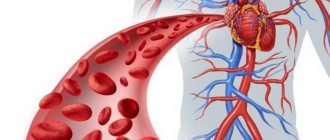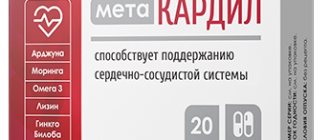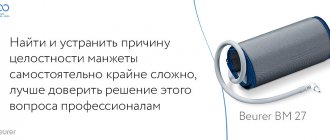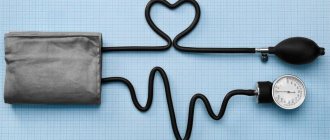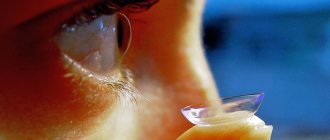The only way to know if you have high or low blood pressure is to measure your blood pressure. Understanding your results is key to controlling your blood pressure.
- Systolic blood pressure (First or top number) is the maximum pressure in the arteries when the heart contracts and pushes blood into the arteries.
- Diastolic blood pressure (Second or lower number) - shows the pressure in the arteries at the moment the heart muscle relaxes, it reflects the resistance of peripheral vessels.
Which number is more important?
Typically, more attention is paid to systolic blood pressure (the first number) as the main risk factor for cardiovascular disease for people over 50 years of age. For most people, systolic blood pressure rises steadily with age due to the loss of elasticity of the large arteries, an increase in heart rate, and the development of vascular disease.
However, an elevated systolic or elevated diastolic blood pressure value can be used to diagnose high blood pressure. The risk of death from coronary heart disease and stroke doubles with a 20 mmHg increase in systolic blood pressure. Art. or diastolic by 10 mm Hg. Art. among people aged 40 to 89 years.
Causes of hypotension
Biophysical factors that are involved in the development of hypotension are:
- Decreasing the amount of venous blood that returns to the heart.
- Decrease in total circulating blood volume.
- Reduced vascular resistance in the periphery.
- Decrease in cardiac output and stroke.
Pathologies of pregnant women
Blood pressure of 100 over 60 during pregnancy, especially in women over 30 years of age, is considered a pathology, especially if symptoms of hypotension are added. Most often, low blood pressure is observed at the end of the first trimester of pregnancy and at 19-23 weeks. Persistent hypotension can cause oxygen starvation of the fetus, which provokes the development of malnutrition and damage to the child’s central nervous system. It is important to monitor the blood pressure of a pregnant woman in order to have time to adjust the numbers.
Teenage years
Adolescents aged 12–13 years experience hormonal changes in the body, which may be accompanied by a decrease in blood pressure. Girls are more likely to face this problem than boys. Hypotension is combined with both accelerated physical development of the body and its slowdown.
Important! A persistent drop in blood pressure during puberty (adolescence) can trigger the development of severe hypertension at a later age.
Psychological characteristics and constitution
Experts say that low blood pressure (for example, 101 to 63, 104 to 64) is more often complained of by patients who are prone to depression and an exaggerated sense of duty. In such cases, treatment is largely aimed not at taking medications, but at using meditative techniques, yoga, breathing exercises, and herbal medicine.
If we talk about the relationship between arterial hypotension and body constitution, then people with an asthenic body type more often complain about a decrease in blood pressure. In such patients, longitudinal dimensions prevail over transverse ones: arms and legs are long, the neck is thin and long, and the muscles are poorly developed.
Lack of physical activity
Modern innovations in technology are causing people to stop moving. Most people prefer to work and relax while sitting at the computer. In this case, not only hypotension occurs, but also cardiovascular diseases, digestive pathologies, and diseases of the musculoskeletal system due to weakness of the muscular system and joints.
Chronic infections
A third of patients who go to doctors with complaints of low blood pressure, dizziness, periodic pulsation in the back of the head and frequent headaches have foci of chronic infection in the body. In this case, hypotension is caused by intoxication, metabolic disorders (metabolism), and circulatory disorders.
Endocrine diseases
The organs of the endocrine apparatus are responsible for the state of the body's hormonal levels. The most common causes of hypotension are Addison's disease (adrenal dysfunction, characterized by a decrease in the amount of hormones produced) and hypothyroidism (lack of thyroid hormones).
Medicines
Long-term or uncontrolled use of medications can serve as a factor in lowering blood pressure. We are talking about the following groups of drugs:
- Sleeping pills.
- Painkillers.
- Antibacterial agents.
- Tranquilizers.
- Sedatives.
- Diuretics, etc.
Blood pressure ranges
In our country, we adhere to the standards of the European Society for the Study of Hypertension, and there are also recommendations from the Ministry of Health of the Russian Federation dated 2021, which established the following ranges of numbers:
- Normal - systolic blood pressure less than 120-129 mmHg, diastolic blood pressure less than 80-85 mmHg.
- Highly normal - systolic blood pressure 130-139 mmHg, diastolic blood pressure 85-89 mmHg.
- 1st degree – 140-159/90-99 mmHg.
- 2nd degree – 160-179/100-109 mmHg.
- 3rd degree – more than 180/110 mmHg.
Note: The diagnosis must be confirmed by a doctor. Hypertension is a disease or diagnosis, and hypertension is the very fact of increased blood pressure. Your doctor may also evaluate any unusually low blood pressure readings and associated symptoms.
Normal pressure
- Optimal blood pressure is SBP less than 120 mmHg. Art. and/or DBP less than 80 mm Hg. Art.
- Normal blood pressure is pressure in the SBP range of 120–129 mmHg. Art. and/or DBP 80–84 mm Hg. Art.
If your results fall into this category, stick to heart-healthy habits such as a balanced diet and regular exercise.
High blood pressure
High blood pressure is when the readings are consistently in the range of above 140 mmHg for systolic and for diastolic more than 90 mmHg. Art. Measures must be taken to control this condition.
Hypertension 1st degree
Stage 1 hypertension is when blood pressure constantly fluctuates systolic between 140–159 and/or diastolic above 90–99 mmHg. Art. During this stage of high blood pressure, doctors may recommend lifestyle changes and may consider taking blood pressure medications. What you do next depends on your risk and risk factors for atherosclerotic cardiovascular disease (ASCVD), such as heart attack or stroke.
Hypertension 2 and 3 degrees
Stage 2 hypertension is when blood pressure is constantly at the level of 160/100 mmHg. or higher. During these stages of high blood pressure, doctors may prescribe a combination of blood pressure medications and recommend immediate lifestyle changes.
Hypertensive crisis
This stage of high blood pressure requires medical attention. If your blood pressure reading suddenly exceeds 180/120 mmHg. Art., wait five minutes, and then check your blood pressure again. If your readings are still unusually high, contact your doctor immediately. You may be experiencing a hypertensive crisis.
If your blood pressure is above 180/120 mmHg. Art. and you are experiencing signs of possible organ damage, such as chest pain, shortness of breath, back pain, numbness/weakness, changes in vision or difficulty speaking, do not expect pressure relief. Call 103
Methods for correcting the condition
If you feel good with low blood pressure, there is no reason to worry. If you feel dizzy and have a headache, other symptoms of hypotension appear, and your pulse is 90 or higher, you should take measures to improve your well-being. To do this you need:
- take a comfortable position and relax, since an attack of hypotension can be triggered by nervous overstrain;
- do not make sudden movements, drink caffeine-containing drinks or alcohol in large doses in the hope that the condition will stabilize;
- take 20 drops of Volocordin diluted with water, valerian or motherwort tincture;
- relieve headaches with Citromon tablets that slightly increase blood pressure.
After 15 minutes, pressure and pulsation will return to normal. After stabilizing your condition, you should consult a doctor who will answer the question of why your blood pressure has dropped in your case, and will be able to prescribe a treatment regimen and give recommendations regarding physical activity and the optimal daily routine.
Blood pressure levels can depend on chronic diseases, age and even the weather. If a decrease in pressure brings discomfort and disrupts the usual rhythm of life, it is worth contacting specialists who can identify and eliminate the causes of the disorder.
Symptoms of low blood pressure
Most doctors consider chronic low blood pressure to be dangerous only if it causes noticeable signs and symptoms, such as:
- Dizziness
- Nausea
- Fainting
- Dehydration and unusual thirst
- Lack of concentration
- Blurred vision
- Cold, clammy, pale skin
- Rapid breathing
- Fatigue
- Depression
A single deviation from normal blood pressure readings is not a cause for concern unless you are experiencing any other symptoms.
Types of hypotonic conditions
Primary hypotension is characterized by a decrease in blood pressure, the causes of which are not pathologies of the heart and blood vessels. Secondary, on the contrary, is a manifestation of a disease. Depending on how long the numbers remain at low levels, acute and chronic forms of the pathological condition are distinguished. In the first case, if we talk about blood pressure 100/60, such numbers remain at a low level for a short time, in the second - over a long period.
Physiological form
We can talk about a physiological variant of hypotension if a pressure of 100/60 (or other low numbers) is discovered by chance, is not accompanied by a deterioration in general well-being and is caused by some physiological reason. Hypotension can be an individual variant of the norm, observed in people actively involved in sports and those living in tropical and subtropical climates.
Pathological form
This type of blood pressure reduction exists in two variations: neurocirculatory and idiopathic orthostatic. The first type manifests itself with a clear clinical picture, the second is characterized by a drop in blood pressure only if the body position changes from horizontal to vertical (for example, when getting out of bed in the morning).
Symptomatic form
She is secondary. It is a symptom of a certain disease. May occur against the background of:
Blood pressure 100 to 80
- Diseases of the heart and blood vessels (heart failure, cardiomyopathy, inflammation of the myocardium, pericardium).
- Pathologies of the respiratory system (pneumonia, tuberculosis, bronchial asthma).
- Diseases of the gastrointestinal tract (stomach and duodenal ulcers).
- Diseases of the renal apparatus (econephropathy, nephritis).
- Pathologies of the nervous system (Parkinson's disease, encephalopathy, cerebral infarction, mental illness).
Reasons why the upper figure may decrease
In the modern rhythm of life, factors such as stress, insufficient rest during intense workload, psycho-emotional experiences, and untimely treatment of underlying diseases lead to a decrease in blood pressure.
Other causes of low upper blood pressure are listed below:
Vegetative-vascular dystonia of the hypotonic type.- Pregnancy period, especially the first trimester, and in patients with severe toxicosis.
- Hormonal disorders, diabetes, hypothyroidism, adrenal insufficiency.
- Consequences of injuries to the head, neck, spine.
- Physical fatigue, especially among professional athletes.
- Congenital or acquired cardiac pathology, valve defects, incorrect selection of medications for hypertension.
- Neurosis, depressive disorder, chronic fatigue syndrome.
- Frequent changes in time zones and climate.
- Sudden change of weather.
- Dehydration, fatigue, consequences of infectious diseases, injuries, operations, blood loss.
Reduced systolic with normal diastolic: why does this happen?
Upper pressure decreases as cardiac contractility decreases. This can happen when:
- damage to the heart and large vessels due to atherosclerosis, rheumatism;
- decreased vascular tone;
- heart failure;
- dysfunction of the autonomic nervous system;
increased secretion of the hormone acetylcholine and decreased adrenaline;- taking sedatives that slow your heart rate.
However, it should be remembered that it is almost impossible to distinguish low systolic pressure from high diastolic pressure on your own. A single measurement of blood pressure at home is not enough to make a correct diagnosis. Cardiologists, therapists and neurologists focus patients’ attention on the need for examination by a specialist. Within the walls of a medical institution, special instrumental diagnostics are carried out to detect low SBP.
Possible complications
Outside of therapy or with an insufficiently high-quality regimen, the following consequences may occur:
- Heart failure. As a result of a drop in output, blood stagnation and a decrease in myocardial contractility.
- Stroke. Acute malnutrition of cerebral structures. Potentially fatal condition.
- Heart attack. Necrosis of the muscle layer. Leads to deficiency, dysfunction and lifelong disability. The possibility of death always looms on the horizon.
- Cardiogenic shock. Carries the greatest danger. Even with timely assistance, no one guarantees the patient’s life. Statistics show that death occurs within 3-4 years, which happens less in almost 100% of people. The cause is a repeated episode of cardiac arrest or massive heart attack.
- Vascular dementia. As a result of constant disruption of nutrition of cerebral structures. Forms a clinical picture similar to that of Alzheimer's disease.
The general decrease in quality of life is a “bonus”. All conditions are associated with premature death.
Preventing such an outcome is one of the goals of treatment. It is solved in parallel with etiotropic and symptomatic effects.
How to solve the problem?
If low SBP is caused by chronic fatigue, insufficient rest or emotional distress, to improve the condition, taking vitamins and sedatives based on Valerian, Motherwort, Peppermint and Melissa is indicated to normalize night sleep. For neurological disorders, B vitamins with Magnesium and ascorbic acid are recommended. However, it should be understood that such treatment is more preventive and cannot eliminate hypotension. Without a doctor's examination, it is impossible to independently identify the true cause of the disorder and raise the upper pressure. Alternative therapy for low systolic blood pressure is not recommended, since taking such medications can mask the manifestations of hypotension, while the underlying cause of the disease will not be identified.
Diagnostic methods
All patients with low blood pressure undergo:
- Electrocardiogram to assess heart rhythm and detect bradycardia.
- Three-time measurement of blood pressure on both arms to assess the difference in pressure, counting heart rate and pulse.
- Holter 24-hour monitoring. Allows you to identify peaks of the lowest and highest SBP over a period of 24 hours, and other deviations.
- Ultrasound with Doppler, Echocardiography. Evaluates the condition of the cavities of the heart, large and small vessels, blood flow, and the functioning of the valve apparatus.
- Listening to the work of the heart with a phonendoscope.
Additionally, laboratory diagnostics are carried out: clinical blood and urine tests, hormones taking into account symptoms, biochemical markers of the lipid spectrum, kidney and liver tests.
What drug therapy is most often prescribed in such a case?
With low upper pressure, treatment is prescribed after receiving the conclusions of all examinations. It is extremely important to identify the cause of the disorder in order to choose the right treatment regimen.
Currently, the following are indicated to raise blood pressure:
| 1. | Medications. | Caffeine, Pantocrine, Citramon, Etilephrine, Rodeola tinctures, Leuzea. |
| 2. | Dosed physical activity. | Walking, stretching, jogging, gentle exercise 30 minutes a day. |
| 3. | Physiotherapy. | Cryomassage, acupuncture, magnetic therapy. |
| 4. | Rejection of bad habits. | Smoking, alcohol, energy drinks. |
| 5. | Normalization of work schedule, sleep and rest, nutrition. | Night sleep is at least 8 hours, daytime sleep is 30 – 60 minutes. Airing the room before going to bed. |
Drug treatment regimens include:
For vegetative-vascular dystonia, take general strengthening and tonic drugs based on herbal components, caffeine, tinctures from the roots of Ginseng, Schisandra.- For chronic fatigue and depressive disorder, antidepressants, sedatives, and sleeping pills are indicated to correct persistent insomnia.
- To improve blood flow, massage of the body, neck, and head is recommended.
- For diabetes, glycemic control, regular use of glucose-lowering drugs are indicated, and for hormonal disorders, appropriate hormone therapy.
- If another concomitant pathology causing hypotension is detected, pathogenetic therapy is prescribed.

